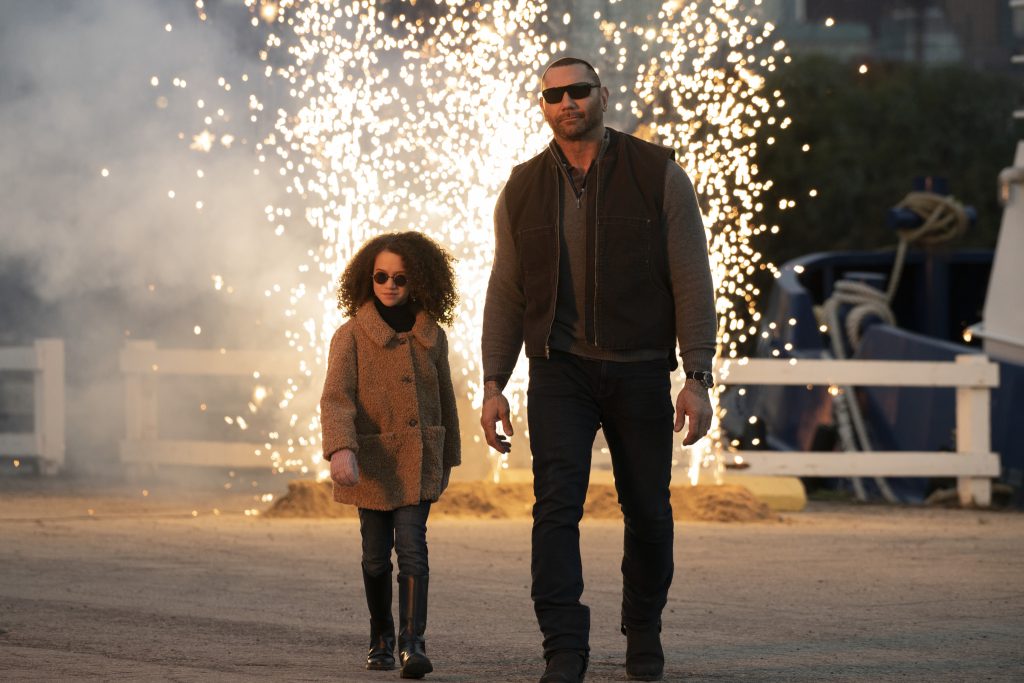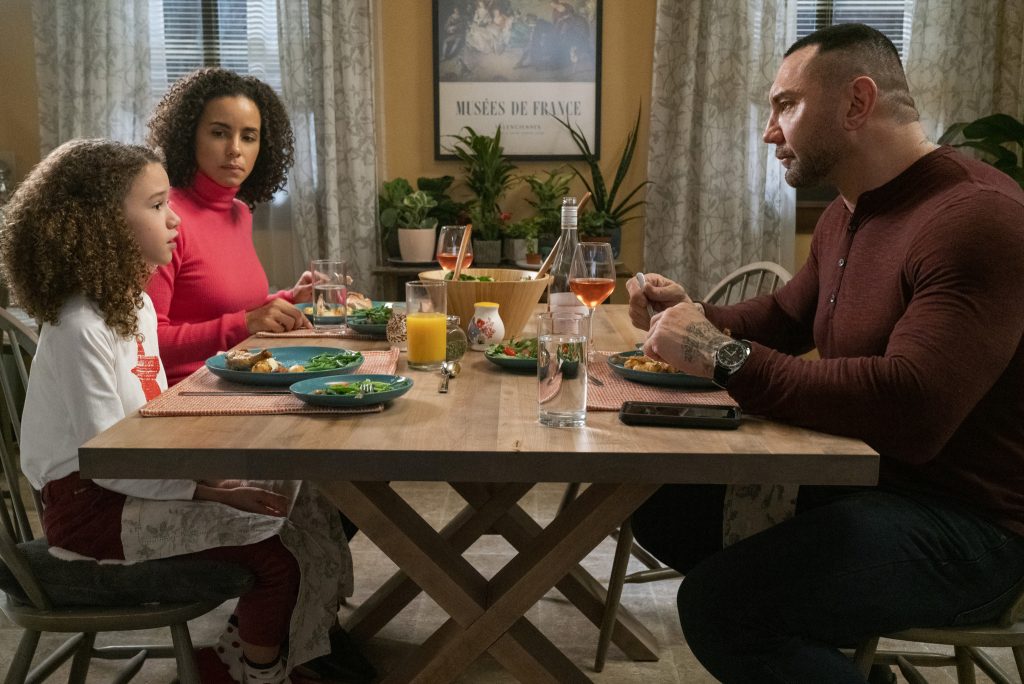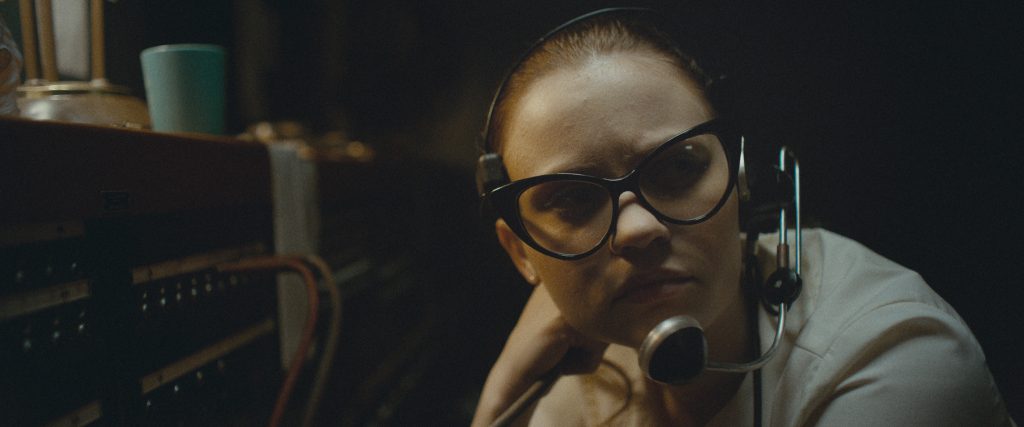July 26, 2020
by Carla Hay
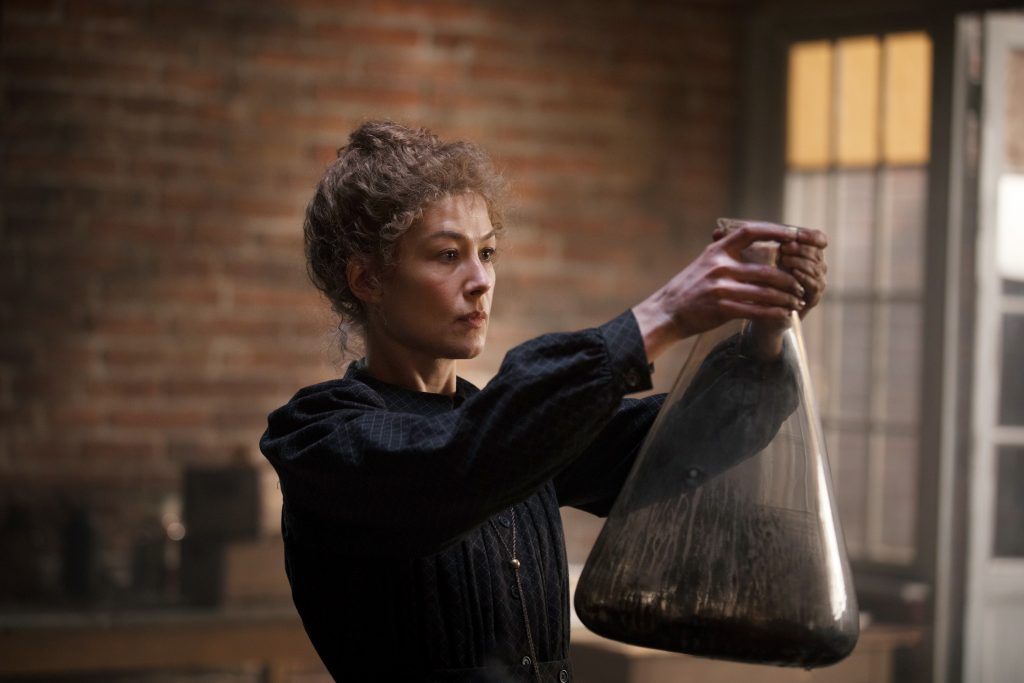
Directed by Marjane Satrapi
Culture Representation: Taking place in France (and briefly in Poland) from 1878 to 1934, the biographical drama “Radioactive” features a predominantly white cast of characters (with some Asians and black people) representing the middle-class in telling the story of scientist Marie Curie.
Culture Clash: Curie battled against sexism and xenophobia, and she was at the center of a scandal when her affair with a married man went public.
Culture Audience: “Radioactive” will appeal primarily to people who like biopics about scientists or women who break through in male-dominated professions, with an emphasis on melodrama over substance.
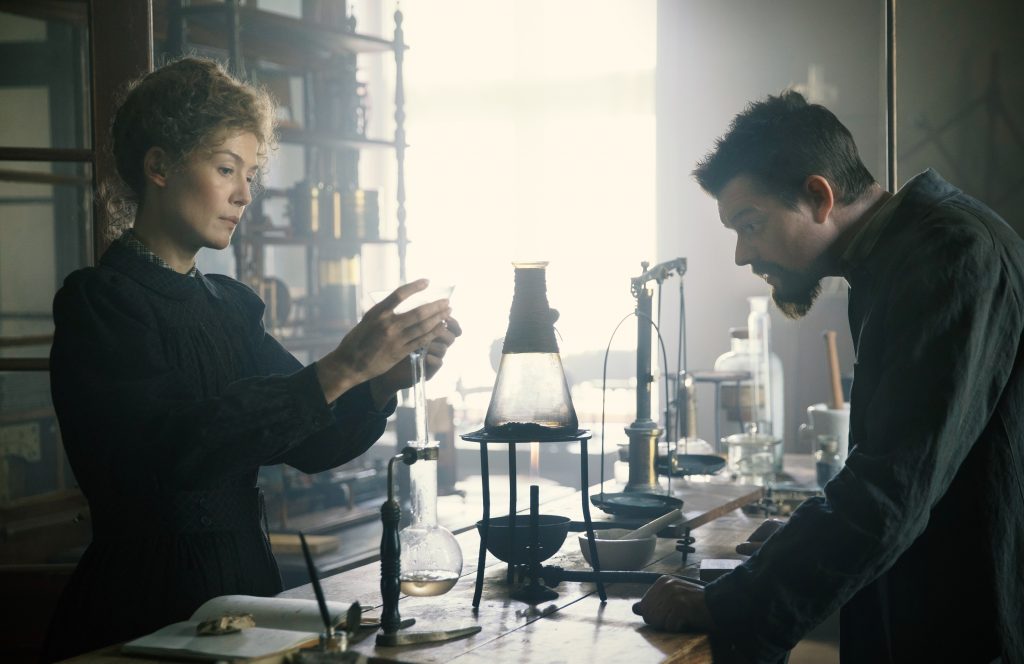
Watching a biographical movie about a scientist, even if the scientist is a world-famous pioneer, might not appeal to a lot of people. And it’s a greater challenge when the story is set more than a century ago. But perhaps to ward off any potential viewer boredom, the filmmakers of the Marie Curie biopic “Radioactive” made the movie as if it’s a both a music video (with lots of flashy, quick-cutting editing) and a melodrama (with plenty of soap opera-type dialogue and over-acting). It’s an overcompensation that ultimately sinks this movie, which had the potential to be a fascinating, award-worthy film, but instead ended up as an unevenly toned misfire.
It’s clear that “Radioactive” was intended to be an “Oscar bait” movie, considering that it was partially financed by Working Title, a British production company that has won several Academy Awards for its films, including 2017’s “Darkest Hour,” 2014’s “The Theory of Everything” and 2012’s “Les Misérables.” “Radioactive” cinematographer Anthony Dod Mantle won an Oscar for 2008’s “Slumdog Millionaire.” And several Oscar nominees were involved in making the film, including star Rosamund Pike (who plays Marie Curie); director Marjane Satrapi (“Persepolis”); and producers Tim Bevan and Eric Fellner.
However, all that talent still doesn’t make “Radioactive” an Oscar-worthy film. Jack Thorne (who has done work mostly in British television) wrote the screenplay as an adaptation from Lauren Redniss’ graphic novel “Radioactive: Marie & Pierre Curie: A Tale of Love and Fallout.” And that’s exactly what the movie looks like on screen: a movie version of a graphic novel.
Scenes that would have benefited from richly witty conversations and glorious, lingering camera shots are instead served with basic, simplistic dialogue and whiplash-like editing that cuts a scene like boxy panels in a graphic novel. Pike certainly gives it her all in this performance, but she’s hemmed in by the hokey screenplay that portrays Marie Curie as less like a brilliant scientist and more like a whiny and egotistical shrew.
The movie begins in Paris in 1934, the year that Marie died of Aplastic anemia from exposure to radiation, at the age of 66. Marie is being rushed to a hospital, and while she’s lying on a gurney, she starts having flashbacks of her life. Those flashbacks are the majority of this story.
The flashbacks begin in Paris in 1893, when an unmarried Marie (whose maiden name was Skłodowska) was the only female scientist working in the University of Paris industrial laboratory of Professor Gabriel Lippmann (played by Simon Russell Beale). Marie, a native of Poland who moved to Paris for her university studies, had changed her first name from Maria to Marie, in order to better fit in with French citizens. In 1893, she had earned a degree in physics and was enrolled in a graduate program while working at Lippmann’s lab. (She would eventually earn a doctorate, supervised by Lippmann, in 1903.)
The movie doesn’t waste time in trumpeting its intent to show Marie as a feisty feminist who constantly has to battle sexism and misogyny. The first flashback scene is of Marie storming into a room where Lippmann and his all-male team of colleagues are seated. She angrily demands to know why her lab equipment has been moved again.
Lippmann tells Marie that it’s because her lab equipment takes up too much space. When she mentions that some of her male colleagues have lab equipment that takes up even more space than her equipment does, Lippmann tells her that she’s been fired. When she protests her dismissal, Lippmann tells her that if she doesn’t like it, she can start her own lab. Marie replies dejectedly that she doesn’t have the funds.
Meanwhile, Marie and a handsome stranger see each other on a street and make small talk. She sees this stranger again while they happen to be attending the same dance performance. They find themselves standing right next to each other, as they watch a female dancer twirling around in a white flowing costume, like she’s auditioning for a Cirque du Soleil show in a future century. This is the “meet cute” moment, because he is a scientist/professor whose name is Pierre Curie (played by Sam Riley), and he confesses to Marie that he’s been admiring her from afar.
Pierre tells Marie that he already knows her name and who she is because (1) “You’re one of only 23 female scientists with the department; (2) I’ve heard about your run-ins with Professor Lippmann; and (3) I read your paper on the magnetic properties of steel. It contains some exceptional science.” Of course, Marie is flattered by his compliment and gives Pierre a compliment too: “I have read your paper on crystallization, which I enjoyed very much.”
In real life, Pierre and Marie were introduced by a mutual friend, but that might have been too boring for the filmmakers, so they invented this scene to make Marie and Pierre’s “meet cute” scene seem more romantic, since the dance performance is filmed to make everything look more fantastically beautiful. At the time that Marie and Pierre met, he was an instructor at the City of Paris Industrial Physics and Chemistry Higher Educational Institution. But Pierre had his own up-and-down relationship with the University of Paris (which was his alma mater too), so Pierre and Marie bond over being “misunderstood” by the university, and they connect over their mutual love of science.
Pierre offers Marie a room to work in his lab. She politely declines, and then she changes her mind after he invites her to look at the work space. Marie firmly tells Pierre that she will not be his mistress, in case he thinks that she’s supposed to repay him by letting him have sex with her. Pierre says that it isn’t his intention, but he does tell her with that certain look in his eye: “I have an instinct about you.”
Of course, since most people watching this movie already know that Marie and Pierre ended up falling in love and getting married, this part of the relationship is shown very quickly. The next thing you know, after a few scenes of Marie and Pierre working together, he proposes (in the most soap opera-ish way possible), they’re married and then expecting their first child.
“Radioactive” does not show much of Marie’s life before she moved to Paris, except for flashbacks of her as a child (played by Harriet Turnbull) having grief-filled moments visiting her terminally ill mother (played by Georgina Rich) in a hospital. (Marie’s mother Bronisława died of tuberculosis when Marie was 10 years old.) According to the movie, this trauma led to Marie’s lifelong fear of being in a hospital. This fear is portrayed in the movie as full-blown panic attacks whenever Marie is asked to go to a hospital and ends up refusing to go.
The only other link to Marie’s Polish past that’s portrayed in the movie is Marie’s sister Bronisława, also known as Bronia (played by Sian Brooke), who was older than Marie by two years and was Marie’s closest female confidant. Bronia doesn’t do much in this movie except give calm and supportive advice when Marie inevitably has to rant or complain about something. (And she gets angry a lot in this movie.)
It’s clear that the filmmakers didn’t want “Radioactive” to be a movie that’s “too smart” for the general public, so Marie and Pierre’s scientific work is explained and depicted in the simplest of terms. When the couple gets a lab in Versailles, France, they discover and present two new elements: polonium and radium. Marie also coins the term “radioactivity.”
Marie and Pierre get widespread acclaim, while viewers of this movie have to sit through a lot of cringeworthy dialogue, with Marie and Pierre saying things like, “We have changed science forever” and “I can feel our work glowing out. I can feel it changing the world.” And if these “change the world” proclamations weren’t enough, “Radioactive” has several moments that cut into the story to actually show examples how the Curies’ discoveries were used in the future.
There’s the scene of a Japanese father and son experiencing the bombing of Hiroshima in 1945. There’s the scene of an atomic bomb being tested in Nevada in 1961, complete with a model house being bombed and life-sized dolls melting inside. There’s the scene of Russian workers rushing in a panic during the Chernobyl accident in 1986.
Of course, when two spouses work together, there are bound to be conflicts and ego clashes. In 1903, Marie, Pierre and Henri Becquerel were awarded the Nobel Prize in physics. Marie’s name was added only after Pierre insisted on it because of her crucial contributions to their discoveries. And so, Marie made history by becoming the first woman to be awarded a Nobel Prize in science.
However, because she was a woman, Marie was not allowed to give a speech at the Nobel Prize ceremony in Stockholm. Pierre says in the movie that Marie could have attended the ceremony, but she declined because she had recently given birth. This is a factual error in the movie, because Pierre and Marie were awarded the Nobel Prize in December 1903. They had two daughters: Irène (born in 1897) and Ève (born in 1904). Ève was born in December 1904, a full year after that Nobel Prize ceremony.
And in the movie, it’s shown that Marie gets very angry with Pierre for deciding to go to the ceremony without her. Did she really expect him to stay at home with her and not go to the ceremony to accept this prestigious award on behalf of both of them? Yes, according to this movie.
Even though Pierre effusively gave praise and credit to Marie in his Nobel Prize speech, that’s still not enough for Marie. When Pierre gets home, she rips into him, as if he committed a major betrayal. As far as Marie is concerned, she did more work than Pierre did, and therefore she deserves more recognition and praise than he gets.
And she cruelly tells Pierre that she will always be smarter than he is. “You stole my brilliance!” she shrieks at him during one of their quarrels over him attending the Nobel Prize ceremony without her. We’ll never know if Marie ever uttered those words to Pierre, but the movie definitely portrays Pierre as a long-suffering husband who has to put up with a mean-spirited wife who has a massive ego.
No one is expecting Marie Curie to be put on a pedestal and look like a saint. But one of the problems with “Radioactive” is that it doesn’t really show Marie being a lot more brilliant than her husband, to justify all the arrogance she has in the movie. The movie shows them working side-by-side as, more or less, equal partners.
And all the temper tantrums that Marie has in “Radioactive” make her look unprofessional to the point where the movie undermines any respect that the filmmakers might have intended for this pioneering scientist. To make matters worse, “Radioactive” continues down the soap opera route when it shows Marie’s life after Pierre tragically died in a carriage accident in 1906.
Marie is understandably devastated by this loss. The movie portrays Marie as someone who was so overcome with grief over Pierre’s death that she began to have hallucinations/visions of seeing him. You get the feeling that the filmmakers would’ve gone as far as Marie consulting a psychic to talk to Pierre from the dead, but that wouldn’t be very scientific, would it?
Instead, there’s a scene where Marie has a breakdown with a photographer, because in Marie’s distraught state of mind, she thinks that there can be a photo conjured up of the spirit of her husband. “Please let me see my husband again!” she shouts numerous times in this over-the-top scene. It looks like a series of retakes from a soap opera.
Two close friends of Marie and Pierre Curie are a married couple named Paul Langevin (played by Anuerin Barnard) and Jeanne Langevin (played by Katherine Parkinson), who are seen earlier in the movie having a pleasant couples dinner with Marie and Pierre. But after Pierre dies, Marie and Paul end up having an affair, and he moves in with her.
The way that the affair is portrayed in the movie, Marie tells Paul that she isn’t in love with him, but he’s clearly in love with her. Marie is obviously using Paul as a way to cope with her grief. And the film makes this abundantly clear when it shows Marie waking up next to Paul and initially hallucinating that Pierre is in his place.
Marie also doesn’t seem too concerned about how this infidelity relationship is affecting her two young children. When Irène and Ève see that their mother has a new man in her bed, and they go in her bedroom to try to talk to her, she asks them if they are hungry. When they say no, she then coldly dismisses them and tells them that if they’re not hungry, then they need to leave her alone.
Of course, the affair causes a major scandal when it’s made public. In the movie, Paul’s wife Jeanne tells Marie that she hired a private investigator and leaked information about the affair to the press. Marie is then the target of intense bullying by strangers, who yell ethnic insults at her about her Polish heritage and tell to go back to Poland.
And so, by the time Marie won her second Nobel Prize (this time for chemistry) in 1911, there was a lot of controversy over her getting the prize because of the scandal in her personal life. People not only protested that she was attending the ceremony but also that she received the prize in the first place. (The movie doesn’t really address the hypocrisy of people never protesting over the untold number of male Nobel Prize winners who openly committed adultery.) Marie was allowed to give a speech at that Nobel Prize ceremony, but the scandal and controversy really tainted what could have been a completely triumphant moment.
Irène is shown as a young woman (played by Anya Taylor-Joy) who would also become a scientist, but the young-adult Irène doesn’t have enough screen time in the movie to get a good sense of what kind of mentorship she got from her mother. It’s yet another missed opportunity in a movie that is more concerned about showing Marie being self-absorbed in her own achievements and the recognition that she thinks she deserved.
Marie Curie remains the only woman to win a Nobel Prize in two scientific fields. But all of her accomplishments and intellectual prowess are devalued by the way “Radioactive” reduces her story to a melodrama. The movie frames her major life events as results of a relationship with whichever man she was sleeping with at the time.
If you were to believe what’s in this movie, Marie saw her first Nobel Prize not as an achievement that she could proudly share with her husband but as a weapon to use against him out of spite, just because other people didn’t want her to give an acceptance speech at the ceremony. That is one of the lasting impressions of Marie Curie that “Radioactive” wants to give, but surely her legacy deserves better.
Prime Video premiered “Radioactive” on July 24, 2020.

